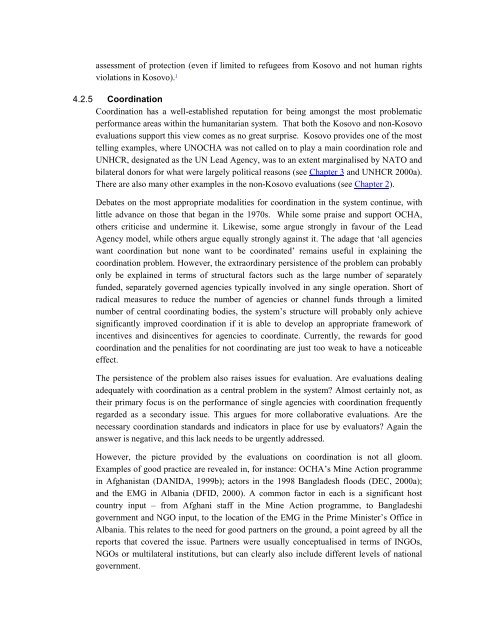Download PDF - ReliefWeb
Download PDF - ReliefWeb
Download PDF - ReliefWeb
Create successful ePaper yourself
Turn your PDF publications into a flip-book with our unique Google optimized e-Paper software.
assessment of protection (even if limited to refugees from Kosovo and not human rights<br />
violations in Kosovo). 1<br />
4.2.5 Coordination<br />
Coordination has a well-established reputation for being amongst the most problematic<br />
performance areas within the humanitarian system. That both the Kosovo and non-Kosovo<br />
evaluations support this view comes as no great surprise. Kosovo provides one of the most<br />
telling examples, where UNOCHA was not called on to play a main coordination role and<br />
UNHCR, designated as the UN Lead Agency, was to an extent marginalised by NATO and<br />
bilateral donors for what were largely political reasons (see Chapter 3 and UNHCR 2000a).<br />
There are also many other examples in the non-Kosovo evaluations (see Chapter 2).<br />
Debates on the most appropriate modalities for coordination in the system continue, with<br />
little advance on those that began in the 1970s. While some praise and support OCHA,<br />
others criticise and undermine it. Likewise, some argue strongly in favour of the Lead<br />
Agency model, while others argue equally strongly against it. The adage that ‘all agencies<br />
want coordination but none want to be coordinated’ remains useful in explaining the<br />
coordination problem. However, the extraordinary persistence of the problem can probably<br />
only be explained in terms of structural factors such as the large number of separately<br />
funded, separately governed agencies typically involved in any single operation. Short of<br />
radical measures to reduce the number of agencies or channel funds through a limited<br />
number of central coordinating bodies, the system’s structure will probably only achieve<br />
significantly improved coordination if it is able to develop an appropriate framework of<br />
incentives and disincentives for agencies to coordinate. Currently, the rewards for good<br />
coordination and the penalities for not coordinating are just too weak to have a noticeable<br />
effect.<br />
The persistence of the problem also raises issues for evaluation. Are evaluations dealing<br />
adequately with coordination as a central problem in the system? Almost certainly not, as<br />
their primary focus is on the performance of single agencies with coordination frequently<br />
regarded as a secondary issue. This argues for more collaborative evaluations. Are the<br />
necessary coordination standards and indicators in place for use by evaluators? Again the<br />
answer is negative, and this lack needs to be urgently addressed.<br />
However, the picture provided by the evaluations on coordination is not all gloom.<br />
Examples of good practice are revealed in, for instance: OCHA’s Mine Action programme<br />
in Afghanistan (DANIDA, 1999b); actors in the 1998 Bangladesh floods (DEC, 2000a);<br />
and the EMG in Albania (DFID, 2000). A common factor in each is a significant host<br />
country input – from Afghani staff in the Mine Action programme, to Bangladeshi<br />
government and NGO input, to the location of the EMG in the Prime Minister’s Office in<br />
Albania. This relates to the need for good partners on the ground, a point agreed by all the<br />
reports that covered the issue. Partners were usually conceptualised in terms of INGOs,<br />
NGOs or multilateral institutions, but can clearly also include different levels of national<br />
government.
















![CynefinFramework final [Read-Only]](https://img.yumpu.com/19017304/1/190x135/cynefinframework-final-read-only.jpg?quality=85)